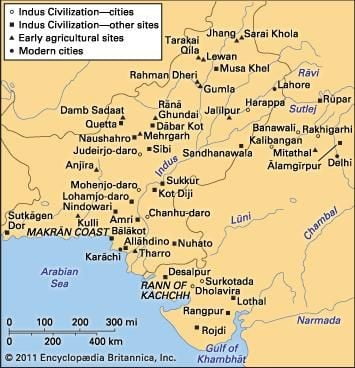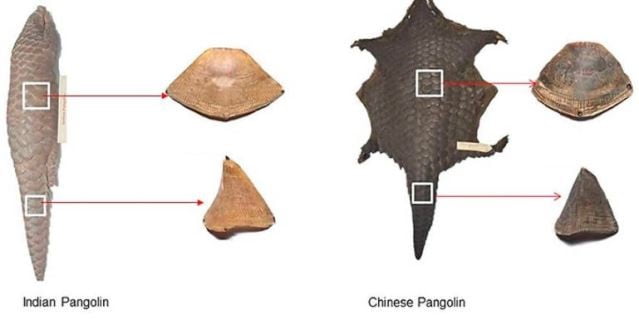IASbaba's Daily Current Affairs Analysis
Archives
(PRELIMS & MAINS Focus)
Syllabus
- Prelims – Ancient History
- Mains – GS 1 (Salient aspects of Art Forms, Literature and Architecture from ancient to modern times)
In News: ASI’s excavation at Harappan site of Rakhigarhi
Rakhigarhi
- It is a Harappan site in Haryana’s Hisar district
- Rakhigarhi is the largest Harappan site in the Indian subcontinent
- The site is located in the Sarasvati river plain, some 27 km from the seasonal Ghaggar river
- At Rakhigarhi, the excavations are being done to trace its beginnings and to study its gradual evolution from 6000 BCE (Pre-Harappan phase) to 2500 BCE.
Finidings
Ongoing Excavation
- The excavation have revealed the structure of some houses, lanes and drainage system, and what could possibly be a jewellery-making unit
- The ASI has also has also revealed pieces of copper and gold jewellery, terracotta toys, besides thousands of earthen pots and seals at excavation
- The noteworthy antiquity found at both the mounds (1 & 3) include steatite seals, terracotta unbaked sealing with relief of elephants and Harappan script.

Previous excavation – Major finidings
- A cylindrical seal with 5 Harappan characters on one side and a symbol of an alligator on the other is an important find from this site.
- Animal sacrificial pit lined with mud-brick and triangular and circular fire altars on the mud floor have also been excavated that signifies the ritual system of Harappans
- Findings also included blades; terracotta and shell bangles, beads of semi precious stones, and copper objects; animal figurines, toy cart frame and wheel of terracotta; bone points; inscribed steatite seals and sealings.

Source: Indian Express, The Hindu
Previous Year Questions
Q.1) Which one of the following ancient towns is well known for its elaborate system of water harvesting and management by building a series of dams and channelising water into connected reservoirs? (2021)
- Dholavira
- Kalibangan
- Rakhigarhi
- Ropar
Q.2) Which one of the following is not a Harappan site? (2019)
- Chanhudaro
- Kot Diji
- Sohgaura
- Desalpur
Syllabus
- Prelims – Science – Health
In News: A case detected in United Kingdom
- Health authorities in the United Kingdom have confirmed a case of monkey pox, in an individual who recently travelled to that country from Nigeria
Monkey Pox
- It is a rare viral infection similar to smallpox
- Monkeypox is a zoonosis, that is, a disease that is transmitted from infected animals to humans.

Monkeypox virus
- The monkeypox virus is an orthopoxvirus, which is a genus of viruses that also includes the variola virus, which causes smallpox, and vaccinia virus, which was used in the smallpox vaccine.
- Monkeypox continues to occur in a swathe of countries in Central and West Africa
- According to the World Health Organisation (WHO), two distinct clade are identified: the West African clade and the Congo Basin clade, also known as the Central African clade
Transmission
- Monkeypox is a zoonosis
- Monkeypox virus infection has been detected in squirrels, Gambian poached rats, dormice, and some species of monkeys.
- Human-to-human transmission is limited
- Transmission can be through contact with bodily fluids, lesions on the skin or on internal mucosal surfaces, such as in the mouth or throat, respiratory droplets and contaminated objects
Symptoms
- Monkey pox begins with a fever, headache, muscle aches, back ache, and exhaustion.
- It also causes the lymph nodes to swell (lymphadenopathy), which smallpox does not.
Treatment
- There is no safe, proven treatment for monkeypox yet. The WHO recommends supportive treatment depending on the symptoms.
Source: Indian Express
Q.1) Which of the following statements is not correct?
- Hepatitis B virus is transmitted much like HIV
- Hepatitis B, unlike Hepatitis C, does not have a vaccine
- Globally, the number of people infected with Hepatitis B and C viruses are several times more than those infected with HIV
- Some of those infected with Hepatitis B and C viruses do not show the symptoms for many years
Syllabus
- Prelims – Environment and Ecology
In News: A Pangolin was rescued from the Ranthambhore Tiger Reserve
Pangolin
- Out of the eight species of pangolin, the Indian Pangolin (Manis crassicaudata) and the Chinese Pangolin (Manis pentadactyla) are found in India.
- Pangolins are scaly anteater mammals and they have large, protective keratin scales covering their skin.
- They are the only known mammals with this feature.
- Insectivore- Pangolins are nocturnal, and their diet consists of mainly ants and termites
- Habitat – Indian Pangolin – It is widely distributed in India, except the arid region, high Himalayas and the North-East.
- Chinese Pangolin – found in the Himalayan foothills in Eastern Nepal, Bhutan, Northern India, and North-East Bangladesh and through Southern China.
Difference between Indian and Chinese Pangolin
- Indian Pangolin is a large anteater covered by 11-13 rows of scales on the back.
- A terminal scale is also present on the lower side of the tail of the Indian Pangolin, which is absent in the Chinese Pangolin.

Status
- Wildlife Protection Act, 1972: Schedule I
- IUCN Red List: Indian Pangolin – Endangered; Chinese Pangolin – critically endangered
- CITES: Appendix I
Threats
- Hunting and poaching for local consumptive use and international trade for its meat and scales in East and South East Asian countries, particularly China and Vietnam.
- They are believed to be the world’s most trafficked mammal
Source: The Hindu
Syllabus
- Mains – GS (Issues relating to Poverty and Hunger)
In News: A recent World Bank Report has shown that extreme poverty in India more than halved between 2011 and 2019 – from 22.5 per cent to 10.2 per cent.
- The reduction was higher in rural areas, from 26.3 per cent to 11.6 per cent.
Reasons for reduction
- Identification of deprived households on the basis of the Socioeconomic and Caste Census (SECC) 2011 across welfare programmes was a game-changer in the efforts to ensure balanced development, socially as well as across regions.
Participation of Women:
- Coverage of women under the Deendayal Antyodaya Yojana and Self Help Groups (SHG) increased from 2.5 crore in 2014 to over 8 crore in 2018
- This provided a robust framework to connect with communities and created a social capital that helped every programme.
Financial Decentralization
- Finance Commission transfers were made directly to gram panchayats leading to the creation of basic infrastructure
- The high speed of road construction under the Pradhan Mantri Gram Sadhak Yojana created greater opportunities for employment by improving connectivity and enhancing mobility.
Credit Access
- The social capital of SHGs ensured the availability of credit through banks, micro-finance institutions and MUDRA loans
Basic Needs
- Thrust on universal coverage for individual household latrines, LPG connections and pucca houses improved standard of living
Co operative federalism
- The competition among states to improve basic needs helped in development
- Example: NITI Aayog SDG index
Monitoring
- Through processes like social and concurrent audits, efforts were made to ensure that resources were fully utilized.
- Still Poverty persists in India
- Pandemic and pandemic induced lockdown – loss of livelihood
- Population Explosion
- Low Agricultural Productivity
- Inefficient Resource utilisation
- Inflation
- Social Factors – Caste system, communal vilolence etc
- Climatic Factors – Extreme Weather events – disasters like cyclone, landslides etc
Way forward
- Realistic Assessment of the present situation of poverty in the country in need of the hour
- Improving social infrastructure and job opportunities in rural areas
- Investment in Agriculture by the government is necessary to decrease rural poverty
- Access to credit, financial inclusion and DBT
- Adoption of ICT to fight corruption
- Involvement of citizen in developmental plans, adoption of bottom-up approach etc
A lot has been achieved, much remains to be done. Strong political will and proper implementation of existing schemes is the need of an hour.
Source: Indian Express
Baba’s Explainer – Sedition Law
Syllabus
- GS-2: Indian Constitution- significant provisions
- GS-2: Functions and responsibilities of the government
- GS-2: Government policies and interventions for development in various sectors and issues arising out of their design and implementation.
Why in News: Recently, the Union government has sought more time to file a reply in a plea challenging the constitutional validity of the sedition charge under Section 124A of the Indian Penal Code.
- The pleas filed by the Editors Guild of India and Major General (Retired) S.G. Vombatkere state that the law causes a ‘chilling effect’ on free speech and is an unreasonable restriction on free expression, a fundamental right.
Read Complete Details on Sedition Law – CLICK HERE
Daily Practice MCQs
Q.1) Arrange the following sites of IVC, from north to south
- Dholavira
- Lothal
- Rangpur
- Alamgirpur
Choose the correct code:
- 1-2-3-4
- 4-2-1-3
- 4-1-2-3
- 4-3-2-1
Q.2) Consider the following statements about Monkey pox
- It is a zoonotic disease
- It is caused by bacteria of the genus Leptospira
- There is no human to human transmission
Choose the incorrect statements:
- 1, 2 and 3
- 2 only
- 1 only
- 2 and 3
Q.3) Consider the following statements
- Pangolins are the only known mammals with protective keratin scales covering their skin
- Both Indian and Chinese pangolins are found in India
- While IUCN status of Indian pangolin is Endangered, Chinese pangolin is critically endangered
Choose the correct statements:
- 1, 2 and 3
- 1 only
- 1 and 2
- 3 only
ANSWERS FOR 9th MAY 2022 – Daily Practice MCQs
| 1 | c |
| 2 | d |
| 3 | a |













